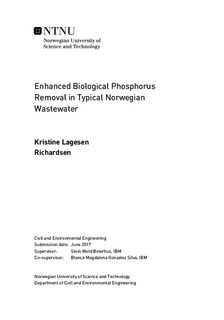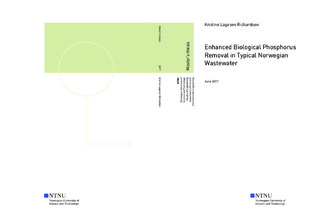| dc.description.abstract | Discharge of wastewater containing excess amounts of nutrients such as phosphorus (P) cause eutrophication of the receiving waterbodies. The consequences related to eutrophication can vary in severity, from esthetical issues to medical threats. The increasing focus on P as a non-renewable resource and the necessity for recovering and recycling P from nutritious wastewater has made biological phosphorus removal (EBPR) in wastewater a more favorable method compared to chemical precipitation. EBPR is a complex process where several essential process conditions and prerequisites make Norwegian wastewater, which typically is diluted and low in nutrients, less ideal for EBPR.
In this study, the possibility of applying EBPR in a local and presumably typical Norwegian wastewater (Lerkendal wastewater) was examined. The objectives of this work were to characterize the unknown wastewater in terms of relevant substances according to EBPR, and perform batch experiments to assess the bio-P activity in the wastewater and subsequent potential for EBPR.
The main results from characterizing the Lerkendal wastewater show that there is a resemblance to typical Norwegian wastewater as there were no significant deviations when compared to literature values. The wastewater is consistent for hourly and daily variation, where the concentration of soluble chemical oxygen demand (sCOD), constituting the substrate for Polyphosphate-Accumulating Organisms (PAOs), showed no signs of diurnal pattern or vulnerability to excess amounts of precipitation. The influent ratio of sCOD:PO4-P and COD:BOD5 is 60.2 and 1.8 respectively, reflecting the biodegradability character of the wastewater and indicate high potential for EBPR.
The main results from batch experiments show a low P release and uptake in the wastewater both with and without external addition of acetic acid (100 mg sCOD/L). The P release rates were between 1.32 and 1.73 P/g VSS*h without acetic acid, which is classified as moderate rates. This indicates poor bio-P activity and negligible fraction of PAOs. Luxury uptake was not detected even with high P uptake rates (6.04 to 10.65 mg P/g VSS*h). The results are related to the condition of the bio-P sludge used in the experiments, which gives reason to suspect that better results could have been obtained if activated sludge was used instead of MBBR sludge.
The results presented give reason to conclude that there is potential for EBPR in the Lerkendal wastewater, however it is limited due to the low concentration of organic substrate naturally present in the wastewater. The concentration of organic substrate can be easily enhanced by installing a hydrolysis tank as a preliminary step before anaerobe bioreactor, and thus increase the potential for EBPR in the Lerkendal wastewater, and presumably Norwegian wastewaters. | |

